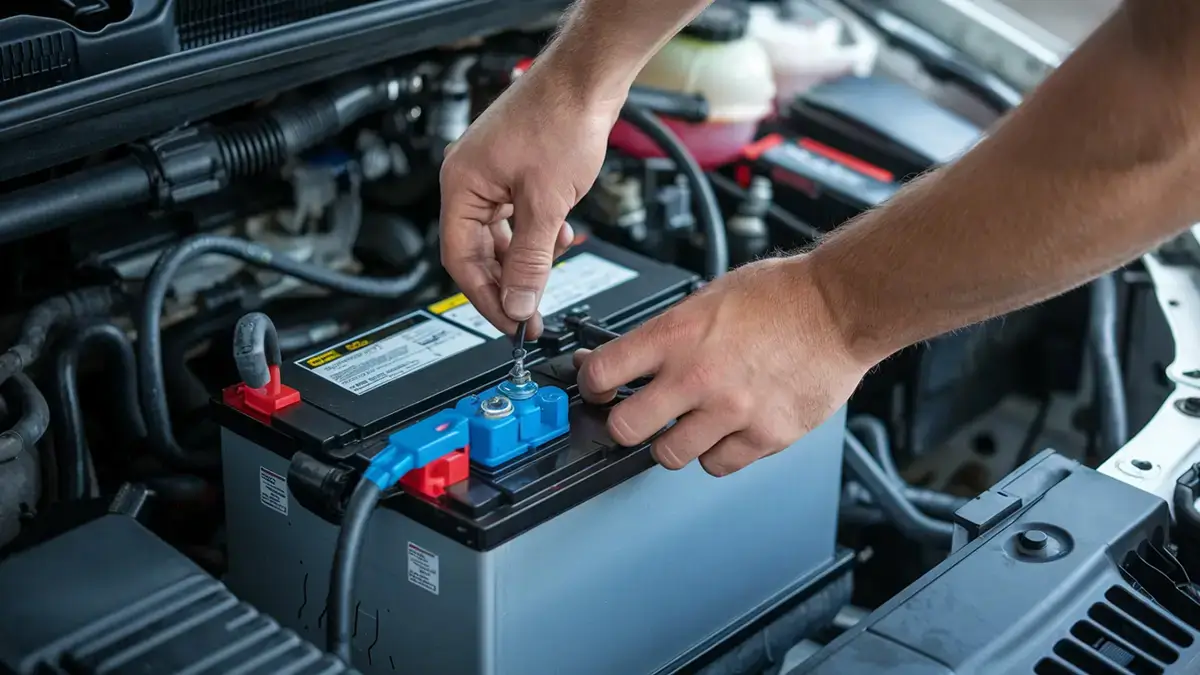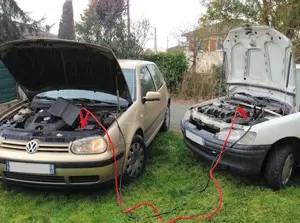Your car battery is essential to the vehicle's operation. Sometimes it can fail, suffer from cold weather, and the battery warning light comes on. What should you do in this situation to fix the problem?
In this article, we’ll focus on the role of the starter battery in combustion engines. In electric vehicles, the battery may also serve as the main energy source for propulsion!


Are you looking for a car scanner ?
The Car Battery: What Is It For?
Just like the alternator, the battery is a key component of your vehicle. When you start the engine, it's the battery that supplies the starter with enough current to crank the engine and power various electronic components in your car.
Likewise, when the ignition is off and you leave the headlights or radio on, the battery takes over to provide the necessary power. On the dashboard, it is represented by this symbol:

Battery Composition
Car batteries are made up of several components:
- Battery cells connected in series: These store energy through chemical reactions and then deliver it as electric current. A standard 12V battery contains six cells.
- Electrolyte: A solution made of 20% sulfuric acid and 80% distilled water.
- To create the chemical reaction: Lead, water, and acid are combined to generate energy.
Key Battery Specifications
Planning to replace your car battery? It’s important to understand its specifications before making a purchase. Always refer to the manufacturer’s recommendations.
First, the physical size. It may sound obvious, but make sure your new battery fits correctly in the designated battery tray in your vehicle.
Next is voltage, expressed in volts (V). Most passenger vehicles use a 12V battery. Trucks typically use a 24V battery. Some older or small-power vehicles may still use 6V batteries.
Lastly, battery capacity is rated in ampere-hours (Ah). The higher the Ah, the more powerful the battery.
How to Maintain a Car Battery
Testing Your Battery
To maintain your battery properly, you need to know its voltage. There are several ways to measure it.
Make sure the engine is off when testing the battery. Since the battery remains under constant charge, it may show voltage even when the engine is off.
The most common method is to use a multimeter and touch the probes to the battery terminals—positive and negative. It should read between 12 and 14 volts. You can also check voltage using your car’s OBD port. If you’re unsure how, check out our video tutorial.
When to Replace It
The average lifespan of a car battery is around eight years. However, if early warning signs appear, it's best to replace it sooner. Ideally, you should replace the battery at the first sign of a potential failure—otherwise, your vehicle might not start at all.
Warning Signs
Several signs can indicate your car battery is about to fail.
In some cases, your vehicle may struggle to start, requiring several attempts before the engine turns over. If you're experiencing this and your battery voltage reads below 11V, it’s time to act.
Also, if the battery terminals show signs of corrosion, that’s a potential indicator of an upcoming failure.
Protecting Your Battery
A few precautions can help extend your battery’s life:
- The most obvious one: always make sure all electrical systems (lights, radio, etc.) are turned off when leaving the vehicle, so you don’t drain the battery unnecessarily.
- Your car battery is sensitive to extreme temperature changes. In cold weather, consider covering the hood with a tarp or blanket to protect it.
- Also, avoid starting the engine multiple times in a row, as this puts additional strain on the battery.
How to Recharge a Car Battery
Using Another Vehicle
If your battery is dead despite precautions, don’t panic. You can resolve the issue without a trip to the garage. One method is to use a second vehicle and a set of jumper cables.

- Turn off both vehicles. Connecting the cables with the engine on could cause sparks.
- Open both hoods.
- Connect the two batteries with the jumper cables: red cable to the positive (+) terminal first, then the black cable to the negative (–) terminal.
- Start both engines and let them run for a few minutes.
- Remove the jumper cables in reverse order.
Using a Battery Charger
If no second vehicle is available, you can use a battery charger. The process is similar to using jumper cables:
- Connect the red clamp of the charger to the battery’s positive terminal.
- Connect the black clamp to the negative terminal.
- Wait several hours for the battery to recharge fully.
Using a Jump Starter (Booster)
You can also use a jump starter to recharge your battery:
- Check the jump starter’s charge—it should be at least 50% full.
- Attach the red clamp to the positive terminal first, then the black clamp to the negative.
- Turn on the jump starter by pressing the power button or turning the dial.
- If the car starts, let the engine run for 30 seconds, then remove the black clamp first, followed by the red.
If the car doesn’t start, wait 30 seconds before trying again.
Now you know what to do if your battery fails! Remember: a battery with no maintenance can fail without warning. If you're new to car repairs and need a replacement, we recommend letting a professional technician handle it at a garage or auto center.
If you found this article helpful, feel free to share it with fellow DIY mechanics! And if you have feedback or questions, leave us a comment!
Stay up to date with Outils OBD Facile news—follow us on Facebook and subscribe to our YouTube channel!

